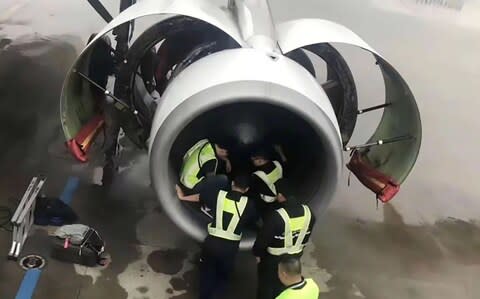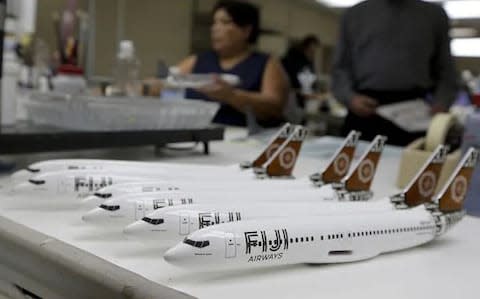Coins and clapping: 8 aviation rituals, from the strange to the dangerous

It's happened again. A superstitious passenger in China delayed a flight to Bangkok for more than an hour on Saturday after throwing coins at the plane's engine for good luck.
This was the fifth incident of its kind so far this year, according to the South China Morning Post. Passengers were boarding a China Southern Airlines flight from the city of Nanning when one woman reportedly chucked six coins at the plane, leading to her detainment and a delay of 78 minutes while crew rallied to retrieve the coins.
The airline later warned customers on social media against such "superstitious" acts, urging: "Abide by aviation safety regulations when taking planes and don't throw things."
In a near-identical case in 2017, an 80-year-old woman tossed nine coins into the engine of a China Southern aircraft from Shanghai to Guangzhou, resulting in a five-hour delay. She was let off with a warning but this year, a 66-year-old was detained for 10 days for committing the same act as she boarded a Tianjin Airlines flight in Mongolia.
It has been suggested that rise of these incidents is a result of more Chinese taking to the skies for the first time than ever before. Indeed, in the first year of the new millennium, a modest 10.5m overseas trips were made by Chinese residents. Fast forward to 2017 and the figure was 145m – an astounding increase of 1380 per cent.

Discussing the risks presented by throwing coins into a plane's engine, a professor at the Civil Aviation University of China said: "The engine could tremble, lose speed and even stop in mid-air if a coin were sucked into its core. That would put all the passengers on board at great risk."
It's dangerous for the same reasons bird strikes are, and in more recent times, drones.
It is perhaps unsurprising given the nature of air travel that people have developed certain rituals over time, whether fear-related or otherwise. Here are some of the other notable practices...
Clapping upon landing
It's less common in modern times as we've grown more used to flying, but mass clapping after a safe landing still occurs. Speaking to Telegraph Travel on the topic, Patrick Smith, a US pilot and author of Cockpit Confidential, remarked: “Clapping upon landing was still widespread as recently as the late Seventies and early Eighties but for most of us the novelty has by now worn off.
“You’ll notice that when it does happen, it’s a strictly economy class phenomenon,” he says. And not for socioeconomic reasons, rather that the dynamics of more people sitting closer together generates a certain “communal spirit”.
So does a good clap give the pilot the warm fuzzies? Oh yes, according to Dave Kistruck, vice president of aircraft operations at Virgin Atlantic: “Although rare these days, it’s always appreciated.”
Lucky numbers
Eight is seen as a lucky number in Asia. Thus, the United Airlines flight UA888 between San Francisco and Beijing hedges no bets by including three cases of the fortunate figure. For the same reason, airlines tend to avoid using the digits '666' when naming a flight route. Though not always. FR666 is Ryanair's flight number for its service between Dublin and Birmingham.
Changing flight numbers following a crash
Airlines generally retire a flight number if that service suffers a fatal accident. Thus MH360 is today the Malaysian Airlines code between Kuala Lumpur and Beijing.
It used to be the now-infamous MH370, until one such service vanished from the skies between Kuala Lumpur and Beijing in 2014, presumably taking the lives of the 239 people on board. The return leg of the journey, formerly MH371, is now MH361.
The same alteration occurred with all four American flights that crashed on September 11, 2001. United Airlines' UA717 - rather than UA175 - is now the number for the link between Boston Logan and Los Angeles International, which struck the South Tower of the World Trade Center.
The exchange of tiny aircraft models
In America, businessmen shake hands. In Japan, they bow. But all over the world airline executives engage in a greeting that is all their own: the exchange of model planes.
When airlines start flying to new cities, make deals with other carriers or finance new jets, these high-quality models - typically one to two feet long - are commonly gifted, in a tradition that has been around for decades. Walk through the headquarters of any airline and rows of models - including those of competitors - can be spotted.
They have their roots with aerospace engineers, who used them in an age before computers to design planes and then test them in wind tunnels. Today, JetBlue CEO Robin Hayes has 15 models in his office and dozens more on nearby shelves. "Some people like going to a museum and looking at art. Some people like a nice bottle of wine," he says. "I like nice model airplanes."

The water canon salute
"The arrival of new jets is a milestone for any airline so launches are often grand, festive affairs featuring the finest champagne and the most VIP of guests, including airline CEOs, ambassadors, sheikhs and princes," writes broadcast aviation analyst Alex Macheras of his job covering such ceremonies. "At these events, a frisson of excitement is palpable in the air." So are huge streams of water.
This “baptism” when new planes are welcomed into the fleet of an airline is a celebratory gesture in aviation, where two fire engines shoot water into the air, creating an arch for the plane to taxi through.
Dice and umbrellas
In 2017, author S.P. MacKenzie collated all the bizarre superstitions that were practiced by military pilots during World War II, for his book Flying Against Fate.
"A lot of combat fliers carried personal charms of one sort or another," he told the Smithsonian's Air&Space. "Pilot George Kenney, for instance, while commanding the Fifth Air Force, always carried a pair of lucky dice."
Of the strangest example he discovered, MacKenzie relayed: "It has to be a rather complicated ritual involving dancing on the wing with an open umbrella before getting down and entering the fuselage of a heavy bomber. This must have taken at least five minutes to complete and looked very odd."

Tapping the fuselage
When it comes to modern passengers, one study we previously covered suggested that more than 65 per cent of us indulge in some sort of good luck ritual when flying.
The survey of 1,894 fliers revealed the most common act was to touch the outside of a plane before boarding it, following by the refusal to sit in certain seat numbers, and the recitation of a mantra or prayer.
The latter is a practice you'll see frequently on board flights operated by Muslim airlines. There are even apps to advise passengers which direction to pray in mid-flight so as to face Mecca.
What are your flight rituals?
Let us know in the comment box below. The stranger the better...

